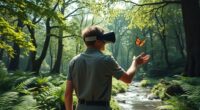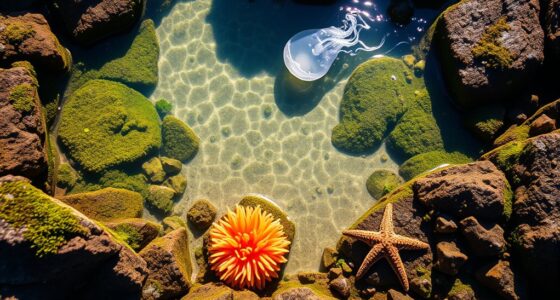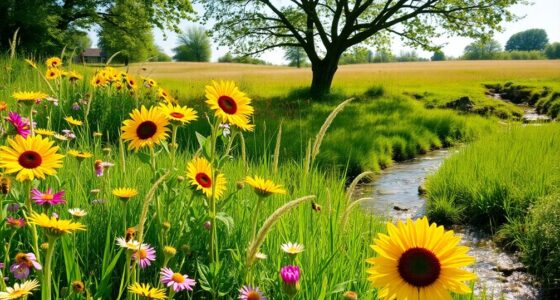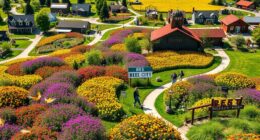As you navigate city streets at night, you might notice some quiet movement or distant sounds that go unnoticed. These are your urban neighbors, creatures that thrive when most people are asleep. Their secret lives are shaped by unique adaptations and behaviors that help them survive in a busy, artificial environment. Understanding these animals reveals a hidden world that plays a vital role in your city’s ecosystem—if you’re willing to look a little closer.
The Adaptations That Enable Urban Wildlife to Thrive
Urban wildlife has developed a variety of adaptations that allow them to thrive amidst human activity. You might notice raccoons using their dexterous paws to open trash cans, or birds adjusting their nesting sites to fit narrow ledges.
These animals often modify their behavior to avoid humans, becoming active during dawn or dusk when activity is lower. Some species have evolved physical traits, like larger eyes for better night vision, helping them navigate the city at night.
Others have developed heightened senses of smell or hearing to detect food and danger more effectively. Their ability to adapt physically, behaviorally, and temporally enables them to survive and even flourish in environments filled with noise, pollution, and human structures. Additionally, color accuracy in visual perception aids many animals in distinguishing subtle changes in their surroundings, increasing their chances of survival in complex urban landscapes.
Common Nighttime Creatures and Their Habits
Many creatures come alive at night, taking advantage of the quieter, less crowded environment. You might hear the chirping of crickets, the hooting of owls, or see raccoons rummaging through trash cans.
Bats swoop through the air, hunting for insects, while foxes silently patrol neighborhoods, searching for small prey. Skunks often come out to scavenge, using their keen sense of smell to find food.
You could also spot neighborhood cats prowling or hear the distant call of frogs near ponds. These animals have adapted to thrive in urban settings, taking advantage of the cover and reduced human activity.
Their habits are a constant reminder that the city never truly sleeps, and wildlife has found a way to coexist with us after dark. Additionally, many of these animals have developed nocturnal behaviors that help them avoid predators and human disturbances.
The Role of Urban Animals in Maintaining Ecosystem Balance
Nighttime creatures play a vital role in maintaining the balance of city ecosystems. As you observe these animals, you’ll notice how they control pest populations, helping prevent overgrowth and disease.
For example, bats and owls hunt insects, reducing the need for chemical pesticides. Small mammals like raccoons and opossums scavenge leftovers, recycling nutrients back into the environment.
By keeping these populations in check, urban animals prevent imbalances that could harm plant life and human health. They also contribute to seed dispersal and pollination, supporting green spaces and biodiversity.
Without their natural behaviors, city ecosystems could become overwhelmed by pests or invasive species. Your awareness of these animals highlights their crucial role in fostering a healthy, resilient urban environment.
How Cities Support and Impact Nocturnal Wildlife
Cities actively support nocturnal wildlife by providing food sources, shelter, and safe passageways that cater to their natural behaviors. Streetlights and illuminated parks attract insects, which serve as food for bats and birds. Green rooftops, vacant lots, and underground tunnels create shelter and hiding spots, offering safe spaces away from predators and human disturbance. Urban waterways and drainage systems act as corridors, allowing animals like raccoons and foxes to move safely through neighborhoods. Additionally, some cities host remote hackathons to develop innovative solutions for urban ecological challenges, encouraging community involvement and technological advancements. However, urban development also impacts nocturnal wildlife negatively—artificial lighting can disorient animals, and infrastructure can fragment habitats. These changes alter their natural patterns, sometimes reducing food availability or disrupting migration.
Ways Humans Can Coexist Respectfully With Nighttime Neighbors
Humans and nocturnal wildlife share urban spaces more closely than many realize, and fostering respectful coexistence benefits both. To start, limit outdoor lighting at night; bright lights can disturb animals’ natural behaviors. Use motion-activated lights instead of constant illumination. Keep trash secure in wildlife-proof containers to prevent attracting animals and avoid feeding wildlife directly, which can lead to dependency or aggression. Create buffer zones by planting native vegetation and maintaining natural habitats around your property. Reduce noise pollution during nighttime hours to help animals feel safe. Educate yourself about local species and their habits, so you can avoid disturbing their routines. Being aware of animal behavior patterns can further enhance coexistence efforts and reduce conflicts with urban wildlife.
Conclusion
By understanding and respecting your nighttime neighbors, you help create a harmonious urban environment. You can support their survival by reducing light pollution, securing trash, and preserving green spaces. Embrace the quiet presence of raccoons, owls, bats, and foxes, knowing they play a vital role in maintaining your city’s health. Together, you can coexist peacefully, ensuring these fascinating creatures continue thriving alongside you in the urban night.







